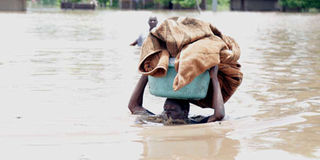Lake Victoria rises, leaving villagers homeless

A resident of Kobura, Nyando in Kisumu County, struggles through flood waters on April 21, 2020. PHOTO | ONDARI OGEGA | NATION MEDIA GROUP
What you need to know:
- Abnormally rainfall has been recorded in Kenya, Burundi, Rwanda, Uganda and Tanzania since October-November 2019.
- Unlike the previous calamities, the flood waters have not spared the usual refuge centres and homesteads that are located on relatively higher grounds.
Residents call them the worst floods ever experienced in the region in many years, and they are now afraid that things could get worse, as heavy rains continue pounding the region and the backflow in Lake Victoria increases.
Lake Victoria has burst its shoreline and the impact of the ever rising water levels since late last year is bringing more trouble for residents of Kisumu, Siaya, Migori, Homa Bay and Busia.
According to a survey conducted by East African Community’s Lake Victoria Basin Commission (LVBC), the prolonged rainfall has caused a drastic rise in Lake Victoria’s water levels by more than two metres.
The commission’s executive secretary, Dr Ali-Said Matano, states that the current bursting of the shoreline is only comparable to an occurrence in the 1960s, where the overflow rose by close to 2.5 metres between 1960 and 1964 (1,136.28 meters above mean sea level).
“At the moment, Kisumu is at 1132.11 metres above mean sea level, Jinja (Uganda) at 1135.8 metres, while Mwanza in Tanzania is at 1134.28 metres,” he told the Nation.
The rising water level in Lake Victoria has been occasioned by a huge imbalance in the inflow and outflow from the fresh water lake.
According to the expert, the lake’s inflow is primarily made of 80 per cent rainfall (precipitation) while rivers pump in 20 per cent.
LIVELIHOODS ENDANGERED
On the other hand, the outflow is majorly from evaporation, which accounts for 76 per cent (less than rainfall) while outflow through River Nile accounts for the remaining 24 per cent.
This explains why the increased rainfall has created an imbalance. In Kisumu alone, an estimated 32,000 people are feared displaced by the floods.
People and beach businesses have been displaced as beaches and islands were submerged.
In Got Agulu, in Siaya County, 78-year-old Richard Onyango, who lost 5,000 banana trees and 3,000 mango trees in a storm last week, says he has witnessed this phenomenon twice in his life.
"I have lived here my entire life and this happens every 30 years. I witnessed it in 1963," he told Nation.
Experts now caution that the onset of long rains could imperil livelihoods further as an unprecedented downpour continues to be recorded in the Lake Victoria catchment areas.
Abnormally rainfall has been recorded in Kenya, Burundi, Rwanda, Uganda and Tanzania since October-November 2019.
In Kisumu - where five people have died in floods since January - residents of lower Nyando are fearing for their lives.
POOR DRAINAGE
Alarm bells sounded on Tuesday after the mighty River Nyando, which drains into Lake Victoria, broke its banks and submerged a half of Ahero shopping centre, stretching to Lela area on the Kisumu-Nairobi highway.
The flash floods spread across villages and displaced thousands of residents who have previously been spared in such calamities.
Hundreds of Kakola Ombaka residents are now worried that the situation could worsen.
“We are concerned that the water that is being drained into Lake Victoria will cause a huge backflow and further damage our property and livestock,” said Mr Leonard Omondi, from Kakola Ombaka.
The raging waters further spread across to the neighbouring villages of Agoro and Kadhiambo in the expansive Nyando. The situation is made worse by the flat terrain and poor drainage.
Unlike the previous calamities, the flood waters have not spared the usual refuge centres, where displaced persons run to, and homesteads that are located on relatively higher grounds.
HOMELESS
Locals term the floods the worst ever to have hit Nyando in many years.
“Usually the flood waters never reach our homestead. For the past 20 years, the floods damaged the rice paddy fields, which are 300 metres away from my homestead,” said Ms Sharon Atieno, whose homestead is adjacent to the road.
She termed these the worst flood seen since her childhood. “The water started rising as early as 9am. I only managed to get hold of my three children. Everything else is trapped in the house,” said Mr Jacob Midika, a resident of Lela, whose house was submerged.
According to Lela chief Lawrence Onyango, more than 800 households have been affected by the floods at Kanyumba village.
“We have plans to move them to Lela Secondary School which is on higher ground,” Mr Onyango told Nation, citing human activities along the banks of River Nyando as one reason the floods have escalated.
Lower Katuoro residents were forced to move to higher grounds under the cover of darkness after raging waters of River Wigwa flooded their homes.
The residents are calling on the government to slow down the curfew restrictions in the light of the emerging flood menace.
“We are likely to witness more of such movements at night; the curfew will not help the situation,” a resident, Mr Dawish Ayunga, cried out.






